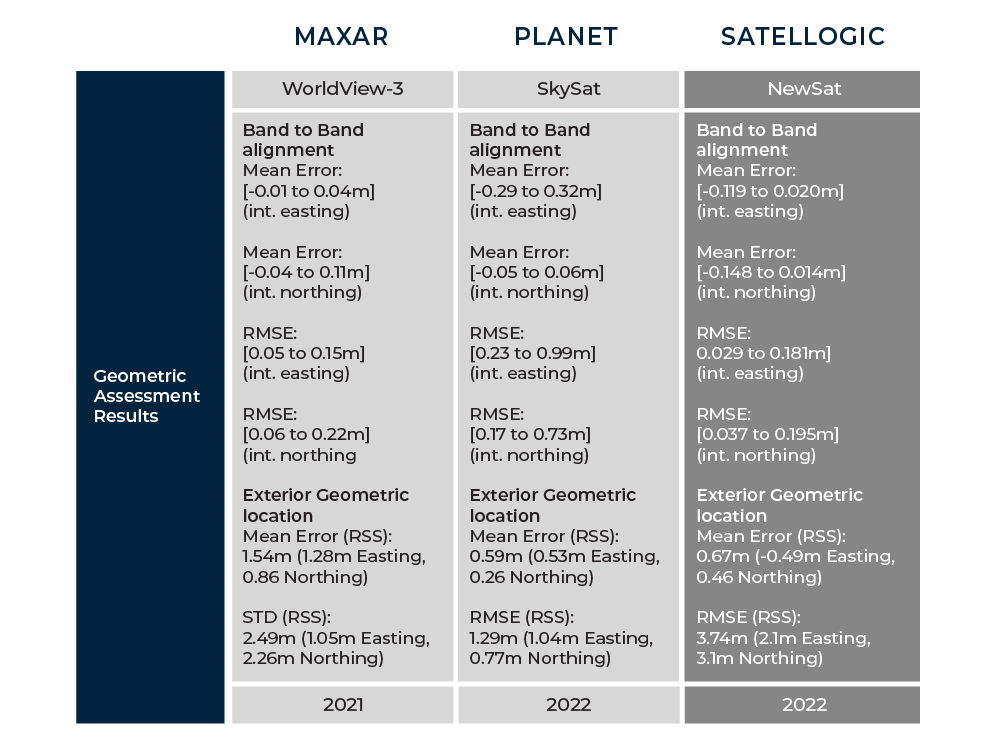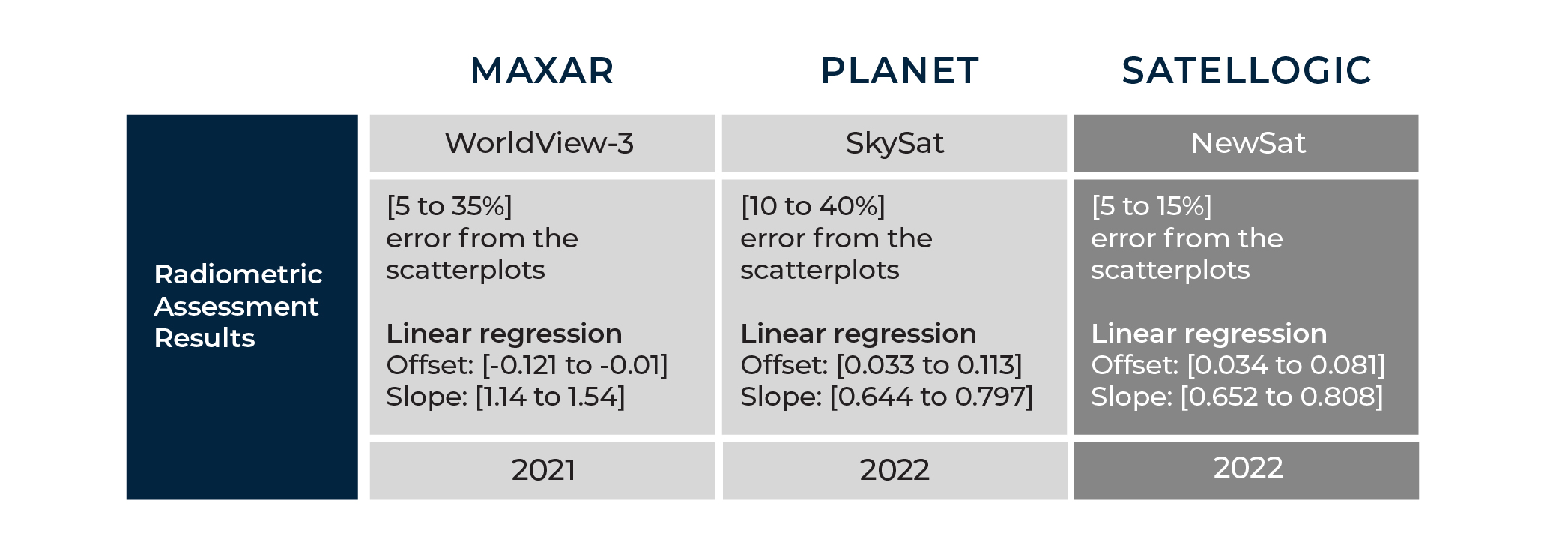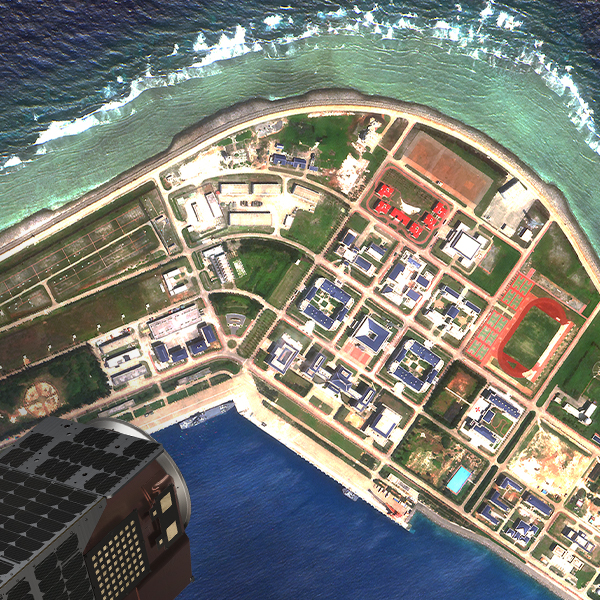
Satellogic 2022 USGS Assessment Results
Review and Commentary on USGS Assessment Results of Satellogic NewSat Multispectral Sensor
In April 2022, the US Geological Survey Earth Resources Observation and Science Cal/Val Center of Excellence published a report addressing the system characterization, or quality, of our NewSat multispectral sensor. This report is conducted to evaluate prominent Earth Observation data providers and emerging remote sensing capabilities. It serves as a critical assessment for the industry, and Satellogic is proud to share positive results as well as to have helped the organization enhance its methodologies.
The report assesses Satellogic’s L1 Product Geometric, Radiometric, and Spatial performance. These results are reported in the Version 1.1, following a correction in methodology.
- Geometric performance pertains to both interior accuracy (how well bands are aligned with one another) and exterior geometric location accuracy, comparing NewSat with the accuracy of Sentinel-2 and ground control points (GCPs).
- Radiometric performance is characterized by Top of Atmosphere Reflectance and was assessed in comparison to Sentinel-2.
- Spatial performance analyzes imagery frequency response, also known as Modulation Transfer Function (MTF). It is also analyzed in terms of Full Width Half Maximum (FWHM), which can be used to define the image resolution in its ability to distinguish two adjacent objects.
The Results
This blog post compares individual USGS assessment results for Satellogic, Maxar, and Planet. The comparisons and commentary are provided by Satellogic. The US Geological Survey Earth Resources Observation and Science Cal/Val Center of Excellence does not issue endorsements.
We feel the results below demonstrate Satellogic’s industry-leading capabilities, echoing recognition from the US National Geospatial-Intelligence Agency (NGA) in its 2021 Olympic-themed evaluation of international Earth observation capabilities in which Satellogic earned gold for its multispectral imagery, silver for hyperspectral, and bronze for average revisit rate.
Geometric
On both interior and exterior geometrical assessment, USGS reports a Mean Error and Root Mean Square Error (RMSE) for both northing and easting axis. Satellogic, according to USGS, achieved a better general performance compared to its main competitors, reaching for the worst measurement a 0.2 sub-pixel RMSE band-to-band geometric accuracy.
This high multispectral alignment product enables various direct and sophisticated applications for our clients, going from object recognition to natural disaster detection through territory monitoring.

Note: For Skysat and NewSat, the exterior geometric assessments were obtained
comparing products with manually collected GCPs, enabling a high precision
in the measurements. While for WorldView, only a comparison with Sentinel 2 was performed,
which has a 10m GSD and some inherent error. Hence this assessment
has a larger interval of confidence, maybe around +-5m.
Radiometic
Satellogic provides scientific radiometric measurements with a high absolute precision and a strong consistency across its satellite fleet and over a wide variety of terrain types. By ensuring the independence of the value we provide with its acquisition set up, we placed ourselves in the unique position of delivering, at scale, ready to use and universal products to our customers.

We expect the error to be as close to 0%, offset to be as close a 0 and slope as close to 1.
We also expect to have the smallest error range.
Spatial
The spatial performance for Satellogic’s NewSat is characterized by the analysis of MTF, from a resolution target . In order to quantify the different image’s power of resolutions, FWHM is considered.
Even with a lightweight and the compact dimension of its optical Payload, Satellogic’s NewSats outperform in its category and manage to compete with the largest satellite in the industry.1

The smaller the FWHM the better. Satellogic provides crisp images which
enable detection of small objects, terrain texture analysis.
Note: Only the Visible bands of Maxar (1.2m GSD) were assessed,
not considering the Pan-sharpened product they obtain from their 0.3m GSD Panchromatic band.

Satellogic aims to be just above 10% as the sweet spot balancing
the trade off between sharpness and aliasing artifact.
While satisfied with these excellent results, Satellogic is anticipating greater technological performance with its Mark V satellite design. Equipped with a new attitude determination and control system, an upgraded optical payload, and a state of the art power generation, the next generation spacecraft will provide increased capacity, at a higher resolution, with industry-leading geometry and radiometry accuracy.
Additionally, we are proud to have collaborated with the USGS team in evolving its procedure in the Modulation Transfer Function (MTF) measurement, a metric that assesses spatial quality, which will refine future EO sensor assessments. The future of EO is bright, and Satellogic is proud to be moving it forward.
About this report
This U.S. Geological Survey Open-File Report provides information from assessments of Earth observation sensors completed by the US Geological Survey Earth Resources Observation and Science Cal/Val Center of Excellence. These reports are provided as independent measures of basic system performance by the Earth Resources Observation and Science Cal/Val Center of Excellence team by completing the geometric, radiometric, and spatial characterization. The results of these assessments are a snapshot in time.
The above information is qualified by reference to Satellogic’s periodic filings with the U.S. Securities and Exchange Commission and other company disclosure.
Sources
1. System characterization report on the Satellogic NewSat multispectral sensor
2. System Characterization Report on Planet SkySat
3. System Characterization Report on the WorldView-3 Imager



